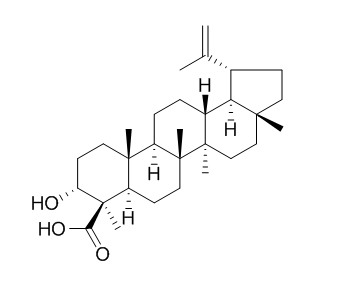Lupeolic acid
Lupeolic acid has anti-inflammatory activity.
Inquire / Order:
manager@chemfaces.com
Technical Inquiries:
service@chemfaces.com
Tel:
+86-27-84237783
Fax:
+86-27-84254680
Address:
1 Building, No. 83, CheCheng Rd., Wuhan Economic and Technological Development Zone, Wuhan, Hubei 430056, PRC
Providing storage is as stated on the product vial and the vial is kept tightly sealed, the product can be stored for up to
24 months(2-8C).
Wherever possible, you should prepare and use solutions on the same day. However, if you need to make up stock solutions in advance, we recommend that you store the solution as aliquots in tightly sealed vials at -20C. Generally, these will be useable for up to two weeks. Before use, and prior to opening the vial we recommend that you allow your product to equilibrate to room temperature for at least 1 hour.
Need more advice on solubility, usage and handling? Please email to: service@chemfaces.com
The packaging of the product may have turned upside down during transportation, resulting in the natural compounds adhering to the neck or cap of the vial. take the vial out of its packaging and gently shake to let the compounds fall to the bottom of the vial. for liquid products, centrifuge at 200-500 RPM to gather the liquid at the bottom of the vial. try to avoid loss or contamination during handling.
Int J Mol Sci.2020, 21(19),7070.
Biomedicine & Pharmacotherapy2022, 153:113404.
Int J Mol Med.2015, 35(5):1237-45
Biosci Rep.2020, 40(8):BSR20201219.
Chemistry of Natural Compounds2018, 54(3):572-576
Environ Toxicol.2024, 39(4):2417-2428.
Phytomedicine.2015, 22(4):498-503
Plants (Basel).2021, 10(12):2795.
Microb Pathog.2024, 189:106609.
Nutrients.2023, 15(12):2644.
Related and Featured Products
J Nat Prod. 2014 Jun 27;77(6):1445-51.
Tetra- and pentacyclic triterpene acids from the ancient anti-inflammatory remedy frankincense as inhibitors of microsomal prostaglandin E(2) synthase-1.[Pubmed:
24844534 ]
The microsomal prostaglandin E2 synthase (mPGES)-1 is the terminal enzyme in the biosynthesis of prostaglandin (PG)E2 from cyclooxygenase (COX)-derived PGH2. We previously found that mPGES-1 is inhibited by boswellic acids (IC50 = 3-30 μM), which are bioactive triterpene acids present in the anti-inflammatory remedy frankincense.
METHODS AND RESULTS:
Here we show that besides boswellic acids, additional known triterpene acids (i.e., tircuallic acid, Lupeolic acid, and roburic acid) isolated from frankincense suppress mPGES-1 with increased potencies. In particular, 3α-acetoxy-8,24-dienetirucallic acid (6) and 3α-acetoxy-7,24-dienetirucallic acid (10) inhibited mPGES-1 activity in a cell-free assay with IC50 = 0.4 μM, each. Structure-activity relationship studies and docking simulations revealed concrete structure-related interactions with mPGES-1 and its cosubstrate glutathione. COX-1 and -2 were hardly affected by the triterpene acids (IC50 > 10 μM).
CONCLUSIONS:
Given the crucial role of mPGES-1 in inflammation and the abundance of highly active triterpene acids in frankincence extracts, our findings provide further evidence of the anti-inflammatory potential of frankincense preparations and reveal novel, potent bioactivities of tirucallic acids, roburic acids, and Lupeolic acids.
J Chromatogr B Analyt Technol Biomed Life Sci. 2003 Jul 5;791(1-2):21-30.
Analysis of pentacyclic triterpenic acids from frankincense gum resins and related phytopharmaceuticals by high-performance liquid chromatography. Identification of lupeolic acid, a novel pentacyclic triterpene.[Pubmed:
12798161]
CONCLUSIONS:
An HPLC gradient method with photodiode array detection was developed for the simultaneous analysis of 12 different pentacyclic triterpenic acids in Indian and African frankincense gum resins as well as in related phytopharmaceuticals. The triterpenic acids were obtained by an exhaustive extraction procedure. Identification of the compounds was based on retention times, UV-spectra and add on technique with standards isolated from African frankincense.
CONCLUSIONS:
The method allows differentiation of frankincense of different origin and standardization of frankincense-based phytopharmaceuticals. Further, this is the first report identifying a novel pentacyclic triterpene, Lupeolic acid, as a constituent of frankincense gum resins.



